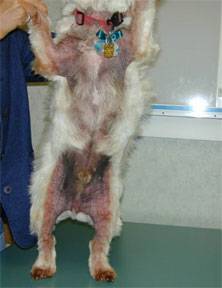Why do animals itch, bite and scratch?
This seems like a pretty straight forward question but in fact finding the answer can be very complicated, time consuming and frustrating. Atopic dermatitis is a very common form of allergy and has been defined as a genetically predisposed inflammatory and pruritic allergic skin disease with characteristic clinical features associated with IgE antibodies most commonly directed against environmental allergens. Similar to humans animals can also suffer from food allergens and parasitic hypersensitivities causing allergic skin disease. Identifying the specific characteristics of allergic skin disease can help to identify the underlying cause of the itch, and then the development and implementation of the treatment plan.
Food related allergies
Food related allergies are often triggered by proteins however other food sources can also be the culprit. Food allergies can begin at any point in the animals life, even if the food has been fed the entire life of the animal. The allergy symptoms can occur within days or hours of feeding the offending item. Itching is often mild to moderate in nature and the distribution of the lesions often involve the ears, feet, head and neck and the ventral abdomen. In some cases vomiting, diarrhea and excessive anal gland production may also occur in conjunction with the skin lesions. Elimination food trials are the key to identifying food allergens. When the skin irritation has cleared up, usually after 3 months of not eating the offending item, re-exposure to the suspected allergen should be performed to confirm the diagnosis. Many times this last step is not pursued because many of us find it hard to intentionally do something that we feel will cause pain and suffering to our pet. I would encourage re-testing the alleged food item because it may be coincidence that the skin problem cleared up without the food and we do not what to have a false diagnosis for what caused of the itch.
External parasites
External parasites, such as fleas and mange can cause intense itching, especially in animals who are allergic to the parasite. Parasites, like fleas, can be easy to diagnose in dogs, but can be quiet difficult to identify in the fastidiously clean cat. Treatments for external parasites have come a long way in the past 10 years. Most veterinary prescribed parasite control products are safe for use, with many being non-pesticide based products. Be aware that many products purchased over the counter at pet stores will contain pesticides which can be harmful to your pet, especially cats. It would be prudent for all pets who have new itching be treated with an anti parasitic medication.
Seasonal environmental allergies
Seasonal environmental allergies such as pollens, grass, and moulds are generally seen in the spring, summer and fall with the severity of the allergic response being worse when the offending allergen is present.

Seasonal Allergies
For some animals this can be seen in the early spring while in others it can be seen in the fall. The symptoms generally recur from year to year at the same time of the year but then resolve during the winter when the offending allergen is not present. When an allergen is present histamine will be released causing several physiological changes within the body and at the level of the skin. The end result is that the animal will feel itchy causing him/her to scratch, chew and lick at the skin. Secondary bacteria and yeast infections are very common in animals because of the damage that occurs to the skin barrier when licking they lick and scratch. If the allergic response is not controlled severe skin infection and pain will occur. Patients with severe skin lesions will require treatment with antibiotics, anti-fungals and anti-inflammatories to heal the skin and control the allergy. There are several types of anti-inflamatories that can be used including vanectylp and prednisone. Unfortunately some patients cannot tolerate these medications and will require other immune modulators such as apoquel or cyclosporine. Anti-histamines and omega 3 fatty acids have shown some promise in helping to reduce allergy symptoms if given prior to the start of the allergic reaction.
Atopic dermatitis (AD)
Atopic dermatitis (AD) has been considered an “inside-outside” disease, that is, a disorder of the immune system manifesting in the skin.

Atopic Dermatitis
More recent research in human AD has focused on the “outside-inside” possibility by examining the role of abnormal skin barrier function on the development of the disease. It is unclear whether the skin barrier dysfunction described in canine AD is a cause or an effect of the disease. AD has no absolute classical clinical signs or definitive tests, so making a definitive diagnosis is more difficult than with other diseases. Atopic dermatitis is a little different compared with environmental allergies because it is often present all year round. The common features of atopic dermatitis include, 1. onset of clinic signs < 3yrs, 2. mostly reside indoors, 3. symptoms resolve with corticosteroids, 4. recurrent and chronic yeast infection, 5. feet are affected, 6. ear pinnas are affected, 7. ear margins are not affected and 8. trunk/back of the body not affected. The presence of 5 of the 8 criteria has a high sensitivity for the presence of atopic dermatitis. However, these criteria do not help to distinguish between food-induced and non-food-induced atopic dermatitis.
Once a diagnosis of atopic dermatitis has been made it is important to rule out other skin diseases that have clinical signs that can resemble, or overlap, that of canine atopic dermatitis, for example external parasites and bacterial skin infection. A detailed review of the clinical signs should be performed and allergy testing performed with the intension of providing allergen-specific immunotherapy. Two allergy tests (intradermal or blood) are commonly used to identify offending allergens. There is no single “best” treatment for dogs with atopic dermatitis. This complex disease has a number of treatment options, and our approaches must be tailored: individualized, flexible, and responsive to change. The components of a patient-specific tailored approach are to 1. reduce pruritus and inflammation, 2. treat and prevent secondary infections, 3. reduce allergen exposure, and 4. alter the immune response.
Similar to animals with environmental allergies, reduction of itch can be accomplished using oral and topical corticosteroids, apoquel, cyclosporine and antihistamines.

Allergy Shampoo
Secondary infections can be treated with antibacterial and antifungal topical shampoos, and oral antibiotics and anti-fungals. Culture and sensitivity testing is always recommended in refractory or recurrent cases. Remove all wool materials such as area rugs and dog beds that contain cedar chips, perfumes, air fresheners, dryer fabric softener sheets to help remove possible allergen exposure. Wipe down the body after being outside, use t-shirts and booties to reduce exposure to outdoor allergens. Bathing regularly and cleaning bedding regularly will all help to reduce allergen exposure. Improving the skin barrier integrity is the focus of intense interest in veterinary medicine as the role of an impaired skin barrier function is undergoing further investigation. Dietary supplementation with omega 3 fatty acid (EFA): The proposed beneficial mechanism of essential fatty acids in atopic dogs is twofold. The first is to direct fatty acid metabolism towards the production of less inflammatory eicosanoids. The omega-6 fatty acid linoleic acid (LA) is important for epidermal lipid barrier function, and supplementation with diets enriched with LA can result in a significant reduction in transepidermal water loss. EFA therapy is not likely to be effective alone in atopic dogs, but may be an appropriate adjunctive therapy for many. It is expected that between 50% and 75% of dogs with atopic dermatitis that have been treated with allergen specific immunotherapy for six to twelve months will require a decrease in anti-inflammatory or anti-pruritic medication. Improvement is expected in 6–12 months in most cases. Oral and intradermal needle allergy serums are available and are formulated based on the allergy testing results. The oral immunotherapy has shown to be effective in about 60% of dogs, including half of those dogs that had failed previous subcutaneous injectible therapy. The patient-specific treatment plan will evolve over time based on the patient response to therapy as well as the patient and client compliance with the different aspects of the plan.
Allergic skin disease is a multi-factorial problem is often not curable and can be difficult to manage. A stepwise diagnostic process is essential in elucidating the diagnosis with the hope of identifying an underlying etiology. Time, open communication and treatment trial an error are often required to develop a successful plan to help and manage the disease. Being itchy is not fun, so remember be patient and work with your veterinarian to help your pet.
Authored by: Dr. Sandi Rosely
